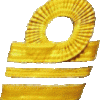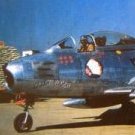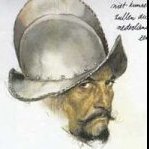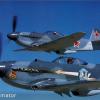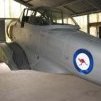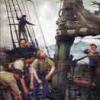-
Posts
1,553 -
Joined
-
Last visited
Reputation Activity
-
 G.L. got a reaction from Mike Y in HMS Triton cross section - FINISHED - by G.L. Scale 1:24
G.L. got a reaction from Mike Y in HMS Triton cross section - FINISHED - by G.L. Scale 1:24
My frames are also a little too short. It is not really a problem for the most of them because their top ends will be hidden by the inner and outer planking, but the fourth futtock of frame sticks out of the sheer rail and must be lengthened at both sides. To have a larger glue surface, I saw them off under an angle of approximate 45° and glue a comfortable long piece on top of it. I do the same with the fourth futtock of frame C because this one remains also visible.
-
 G.L. got a reaction from Captain Poison in HMS Triton cross section - FINISHED - by G.L. Scale 1:24
G.L. got a reaction from Captain Poison in HMS Triton cross section - FINISHED - by G.L. Scale 1:24
The notches for those lintels have to be filled.
103.bmp
-
 G.L. got a reaction from mtaylor in HMS Triton cross section - FINISHED - by G.L. Scale 1:24
G.L. got a reaction from mtaylor in HMS Triton cross section - FINISHED - by G.L. Scale 1:24
Of course the gun port lintels are also too low, therefore I saw them out.
-
 G.L. got a reaction from Jolley Roger in HMS Triton cross section - FINISHED - by G.L. Scale 1:24
G.L. got a reaction from Jolley Roger in HMS Triton cross section - FINISHED - by G.L. Scale 1:24
On my Proxxon saw table I like to use a table saw sledge on which a millimeter paper is glued with the 0 mm line exactly on the saw blade edge. With the help of that sledge it is easy to saw 3 mm wide grooves of 1.5 mm deep at 3 mm intervals.
-
 G.L. reacted to EdT in Young America 1853 by EdT - FINISHED - extreme clipper
G.L. reacted to EdT in Young America 1853 by EdT - FINISHED - extreme clipper
Young America - extreme clipper 1853
Part 261 – Fore Topsail Yards
I have finally been able to break out of the ratline work to start on the next set of yards – specifically the fore lower and upper topsail yards. These will likely be the next two to go up, but the main yard is also an option. I want to get all the ratline work done on the lower and upper masts before staring on the yards. I got ahead of myself with the fore yard and that made finishing the ratlines a tougher job.
I described the methods I am using to make spars in Parts 217-218 and Parts 247-248, so I will not go through it all again. I will mostly stick to some things that may not have been covered earlier.
I generally like to drill all the holes in a spar at the first trim. At this stage it is sized but still square and not tapered, so it is easier to hold and center the piece. I forgot to do this on the lower topsail yard so it had to be done later as shown in the first picture.
In the picture the holes for the jackstay stanchions are being drilled. The yard is clamped to the tooling plate at the octagonal center area and at the yardarm square section – not optimum but not too difficult.
In the next picture the upper topsail yard is set up for drilling while still at the first trim.
In the earlier description of this drilling I used the mill vise, but since I had the tooling plate set up I decided to use it instead. To make the yard parallel with the plate, I used the small depth gauge described back during the deck framing. The next picture shows the jackstay stanchion holes drilled into this yard.
The stanchion holes are the most important to do at this stage because they need to be centered on top of the yard and equally spaced. Other holes will be drilled later. In the picture the quarters are marked out. In the next picture dividers are being used to mark the diameters on two opposite sides at each quarter.
These are taken directly from the drawing and serve as guides for the first roughing out only. The final dimensions at each quarter will be measured and adjusted more accurately as shown below. In the next picture the two marked faces are being tapered using a plane with the yard clamped in a vise.
The vise works well before the spar is tapered. The fixture described earlier and shown below could also be used. The taper is planed, scraped, rasped and sanded down to the divider marks. In the next picture calipers are being used to check and refine the sizing to the dimensions specified on the drawing.
The drawings specify the diameter at each quarter in full size decimal inches, which are then divided by 72 to get the measurements to the three significant digits used in the final sizing as shown above. The sandpaper board is used for the final sizing.
With the spar tapered on two sides, the planning fixture shown below was then used to taper the remaining two faces.
For these smaller spars the top section of the stop was removed to clear the plane. In the next picture one of the remaining two sides are being tapered.
The yard was then converted to an octagonal shape, except at the yard arms, as described in the earlier posts. The center area on these "single-tree" spars were left octagonal, so the final rounding begins at the end of the octagonal section as shown below.
After filing off the corners of the octagon, the rounding was completed down to the square yardarm section using the sanding stick shown.
This has 220-grit paper on one side and 320-grit on the other. The last picture shows the two topsail yards ready for their ironwork.
Ed
-
 G.L. got a reaction from mtaylor in Oostends schipje by G.L. - scale 1:20 - Ostend shrimper - first POF - Edition 2
G.L. got a reaction from mtaylor in Oostends schipje by G.L. - scale 1:20 - Ostend shrimper - first POF - Edition 2
Yes Nils, I use strips of 220 grams black paper which I glue at the side of the planks with ordinary white wood glue before fixing them on the deck beams.
G.L.
-
 G.L. got a reaction from KORTES in Oostends schipje by G.L. - scale 1:20 - Ostend shrimper - first POF - Edition 2
G.L. got a reaction from KORTES in Oostends schipje by G.L. - scale 1:20 - Ostend shrimper - first POF - Edition 2
12.31
The composed winch. The stringers are continuing below the deck and are still kept together with an elastic until the glue is dry.
-
 G.L. got a reaction from Mirabell61 in Oostends schipje by G.L. - scale 1:20 - Ostend shrimper - first POF - Edition 2
G.L. got a reaction from Mirabell61 in Oostends schipje by G.L. - scale 1:20 - Ostend shrimper - first POF - Edition 2
12.27
I make the capstan roll of a square piece of oak of which I plane off the corners till it is a octagon. Then I drill a hole in the center in which the shaft of the cog-wheels fits.
-
 G.L. got a reaction from Mirabell61 in Oostends schipje by G.L. - scale 1:20 - Ostend shrimper - first POF - Edition 2
G.L. got a reaction from Mirabell61 in Oostends schipje by G.L. - scale 1:20 - Ostend shrimper - first POF - Edition 2
12.24
I finish the hatch with sanding it and adding corner-claps to the corners.
-
 G.L. got a reaction from Mirabell61 in Oostends schipje by G.L. - scale 1:20 - Ostend shrimper - first POF - Edition 2
G.L. got a reaction from Mirabell61 in Oostends schipje by G.L. - scale 1:20 - Ostend shrimper - first POF - Edition 2
Yes Nils, I use strips of 220 grams black paper which I glue at the side of the planks with ordinary white wood glue before fixing them on the deck beams.
G.L.
-
 G.L. got a reaction from aviaamator in La Jacinthe 1825 by aviaamator - 1:20 - schooner
G.L. got a reaction from aviaamator in La Jacinthe 1825 by aviaamator - 1:20 - schooner
Aviaamator,
Your tree nails with the dark edge look fantastic!
G.L.
-
 G.L. reacted to aviaamator in La Jacinthe 1825 by aviaamator - 1:20 - schooner
G.L. reacted to aviaamator in La Jacinthe 1825 by aviaamator - 1:20 - schooner
The Old New Year! The sailors got confused... the Captain in disbelief! Where the right capstan?
-
 G.L. reacted to aviaamator in La Jacinthe 1825 by aviaamator - 1:20 - schooner
G.L. reacted to aviaamator in La Jacinthe 1825 by aviaamator - 1:20 - schooner
Pete! Buddy! The thickness of the metal strip different all along, I did it with my hands and a small file. It is not difficult, much more difficult to properly install these hinges.The CNC machine I built not for himself. My friend asked me to make this machine, and I could not refuse! Photos of the CNC :
-
 G.L. reacted to aviaamator in La Jacinthe 1825 by aviaamator - 1:20 - schooner
G.L. reacted to aviaamator in La Jacinthe 1825 by aviaamator - 1:20 - schooner
All this time we did not sit without work! And here is the result! Perhaps I could better fulfill this unit, but I'm still happy! And Captain Jack too!
-
 G.L. reacted to Wintergreen in Kågen by Wintergreen - FINISHED - 1:30 - Swedish clinker-built cog work boat - SMALL
G.L. reacted to Wintergreen in Kågen by Wintergreen - FINISHED - 1:30 - Swedish clinker-built cog work boat - SMALL
Hi all,
Re the book; it covers a replica build of the original boat from 1900. Since these boats always were build without plans, the book contains no blueprints. The original boat was measured and from this they made a couple of plans, which are part of the book. Will show you later.
Now for todays update. In my earlier post I headed out to my shop in order to create some kind of thickness sander. So far, so good.
I have yet to try it out with sanding paper, but I think it might work. In the future there will probably be room for updates on some of the details of it.
The aluminium drum is held in place by squeezing only. Might need another way, but the friction seems good enough.
As you can se the height of the table is adjusted by a knurled knob attached to a M6 threaded rod. One full turn raises the table 1mm at the aft end. The drum is approximately 2/3 up the table. One full turn would then approximately lessen the space drum-table with 2/3 of a mm. (I guess).
The table is hinged at the front end.
I also need to build some dust extraction for it. But that will be quite easy, just some cover to stand over the whole unit with an outlet to attach a hose to.
We will see.
To be continued...
-
 G.L. reacted to Derek C in HMS Triton Cross Section by Derek C - FINISHED
G.L. reacted to Derek C in HMS Triton Cross Section by Derek C - FINISHED
I made the center supports for the lower deck the plans showed square post , but I like the looks of the way G.L. did his , so I knocked off the corners starting from 1/4 “ in from both ends.
and i I drilled the ends to slide in my pegs .
Then I drilled holes in the bottom side of the lower deck and keelson and assembled and glued down the lower deck . That felt like a milestone lol .
While I wait for the glue to dry I started cutting out pieces for the Main Sheet bits. First I cut blood wood to the desired size and sanded it to the final demensions shown on plan. I then used a coping saw and files to cut my notches
Using a drill press I drilled the spots for the sheaves as Tony K and G.L . did in there logs.
Now that the glue has dried and I have removed the clamps here is a few pictures of how she is looking.
Thanks for looking in on my build.
Derek C
-
 G.L. got a reaction from PeteB in La Jacinthe 1825 by aviaamator - 1:20 - schooner
G.L. got a reaction from PeteB in La Jacinthe 1825 by aviaamator - 1:20 - schooner
Aviaamator,
Thinking a lot about you. Wishing you a lot of strength. I am praying for you that everything is turning well.
I am sure that the whole Model ship world community is supporting you.
G.L.
-
 G.L. got a reaction from PeteB in La Jacinthe 1825 by aviaamator - 1:20 - schooner
G.L. got a reaction from PeteB in La Jacinthe 1825 by aviaamator - 1:20 - schooner
I see no mistakes. I wish that I could make such nice carvings.
G.L.
-
 G.L. got a reaction from tarbrush in Oostends schipje by G.L. - scale 1:20 - Ostend shrimper - first POF - Edition 2
G.L. got a reaction from tarbrush in Oostends schipje by G.L. - scale 1:20 - Ostend shrimper - first POF - Edition 2
I use an oxidant which is called 'oxidant 1130', it is mainly used for brass but it works also with copper. I don't know the exact name or the composition of the product. I buy it in a shop for artist products in Ghent (Belgium): 'De gouden pluim' ( http://www.degoudenpluim.be/ ). They fill it in the wanted amount in plastic bottles.
-
 G.L. got a reaction from tarbrush in Oostends schipje by G.L. - scale 1:20 - Ostend shrimper - first POF - Edition 2
G.L. got a reaction from tarbrush in Oostends schipje by G.L. - scale 1:20 - Ostend shrimper - first POF - Edition 2
12.38
The edges of the handles are filed round and blackened and finally nailed on the planks.
-
 G.L. got a reaction from tarbrush in Oostends schipje by G.L. - scale 1:20 - Ostend shrimper - first POF - Edition 2
G.L. got a reaction from tarbrush in Oostends schipje by G.L. - scale 1:20 - Ostend shrimper - first POF - Edition 2
12.37
I hammer the edges flat and drill a nail hole in the flattened part.
-
 G.L. got a reaction from tarbrush in Oostends schipje by G.L. - scale 1:20 - Ostend shrimper - first POF - Edition 2
G.L. got a reaction from tarbrush in Oostends schipje by G.L. - scale 1:20 - Ostend shrimper - first POF - Edition 2
12.36
The handles are made of pieces of brass tubes of 2mm diameter.
-
 G.L. got a reaction from tarbrush in Oostends schipje by G.L. - scale 1:20 - Ostend shrimper - first POF - Edition 2
G.L. got a reaction from tarbrush in Oostends schipje by G.L. - scale 1:20 - Ostend shrimper - first POF - Edition 2
12.35
Each of the covering planks has two handles. Below the handles is a shallow deepening. I make it with a round mill.
-
 G.L. got a reaction from mtbediz in Oostends schipje by G.L. - scale 1:20 - Ostend shrimper - first POF - Edition 2
G.L. got a reaction from mtbediz in Oostends schipje by G.L. - scale 1:20 - Ostend shrimper - first POF - Edition 2
12.34
The making of the hatch-way and the planks don't need a lot of explanation.
-
 G.L. got a reaction from tarbrush in Oostends schipje by G.L. - scale 1:20 - Ostend shrimper - first POF - Edition 2
G.L. got a reaction from tarbrush in Oostends schipje by G.L. - scale 1:20 - Ostend shrimper - first POF - Edition 2
12.33
Behind the winch is the shrimp cooking store. On top of it there is also a hatch-way which is covered with removable planks.


